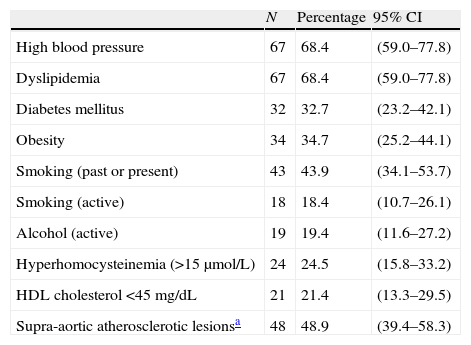The importance of vascular risk factors (VRF) and hypercoagulable state in patients with retinal vein occlusion (RVO) has not been conclusively established.
ObjectivesTo analyze the relevance of VRF, prevalence of thrombophilia, and ultrasonography findings in the supra-aortic trunks in patients with RVO.
Patients and methodsA prospective study was performed of all the patients diagnosed of RVO referred to an Internal Medicine clinic. The clinical, laboratory (including a thrombophilia panel) and ultrasonographic variables were analyzed.
ResultsA total of 98 patients (56 men, 42 women) mean age 66 years were studied. Hypertension and dyslipidemia were the most prevalent VRF. Of these, 24% had hyperhomocysteinemia and atherosclerotic plaques were detected in the supra-aortic trunks in 48%. RVO was peripheral in 69 and central in 29. Genetic thrombophilia was detected in 13% and it was acquired in 9%. Thrombophilia was observed in 50% of subjects aged <50 years and in 67% of those without VRF (p=.004). Seventy-seven percent received antiplatelet drugs. Seven were on anticoagulants due to atrial fibrillation, although this did not prevent the development of RVO. Anticoagulation treatment was initiated in 4 cases, this being maintained indefinitely in the three patients diagnosed with antiphospholipid syndrome.
ConclusionsIn patients with RVO, it may be recommendable to control classical VRF and measure serum homocysteine levels. Our data also suggest that antiphospholipid syndrome should be ruled out and that a study of thrombophilia should only be considered in subjects aged <50 years or without VRF. Antiplatelet therapy with aspirin is the treatment of choice to reduce the overall vascular risk. Anticoagulation should only be considered in those patients with high-risk thrombophilias.
No está establecida de forma definitiva la importancia de los factores de riesgo vascular (FRV) y del estado de hipercoagulabilidad en los pacientes con obstrucción venosa retiniana (OVR).
ObjetivosAnalizar la importancia de los FRV, la prevalencia de trombofilia y los hallazgos ecográficos en los troncos supraaórticos en los pacientes con OVR.
Pacientes y métodoEstudio prospectivo de todos los pacientes con OVR remitidos a una consulta de Medicina Interna. Se analizaron las variables clínicas, de laboratorio (incluido un estudio de trombofilia) y ecográficas.
ResultadosSe estudiaron 98 pacientes (56 varones y 42 mujeres) con una media de edad de 66 años. La hipertensión y la dislipemia fueron los FRV más prevalentes. Tenían hiperhomocistinemia un 24% y presentaban placas de ateroma en los troncos supraaórticos el 48%. La OVR fue periférica en 69 y central en 29. En un 13% se detectó una trombofilia genética y en un 9% adquirida. En los sujetos menores de 50 años la trombofilia se observó en el 50% y en los que no tenían FRV en el 67% (p=0,004). El 77% recibieron antiagregantes. Siete estaban anticoagulados por fibrilación auricular y ello no evitó la aparición de la OVR. En 4 casos se inició anticoagulación que se mantuvo de forma indefinida en los 3 pacientes con síndrome antifosfolípido.
ConclusionesEn los pacientes con OVR parece recomendable el control de los FRV clásicos y la determinación de los niveles de homocisteína. Nuestros datos sugieren además, descartar la presencia de un síndrome antifosfolípido, y solamente en los sujetos menores de 50 años o sin FRV se podría considerar un estudio de trombofilia. La antiagregación con aspirina es el tratamiento recomendado para reducir el riesgo vascular global, y solo se consideraría la anticoagulación en aquellos con trombofilias de mayor potencial trombótico.
Article
Diríjase desde aquí a la web de la >>>FESEMI<<< e inicie sesión mediante el formulario que se encuentra en la barra superior, pulsando sobre el candado.

Una vez autentificado, en la misma web de FESEMI, en el menú superior, elija la opción deseada.

>>>FESEMI<<<






